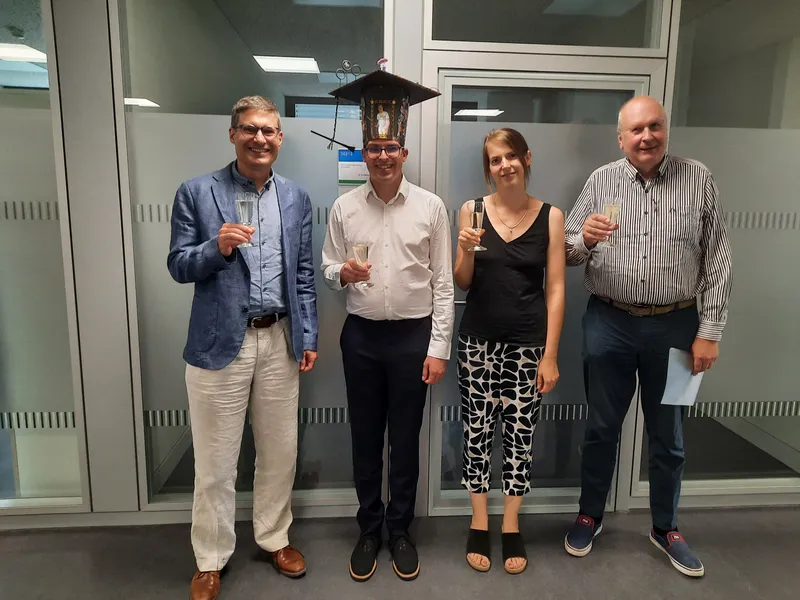Christopher Wabnitz succcessfully defended his PhD Thesis-Congratulations!

Novel Strategies to Guide Sample Preparation for Compound-Specific Isotope Analysis
Abstract
NOM and the consequently smaller electrostatic repulsion between NOM molecules. The presented findings
prove the importance of NOM’s anionic character for the sorption on MIPs and provide a knowledge base for
future research on non-specific binding of the sample matrix NOM during MISPE.
The second and major part of the thesis addressed the challenge of developing a detection technique that can
quantify matrix components online during RP HPLC. For this purpose, this thesis investigated the suitability
of quartz crystal microbalance (QCM) using two different strategies: (i) QCM liquid sensing and (ii) QCM
dry mass sensing. First, a suitable coating must be found to quantify matrix components in the liquid phase
using QCM liquid sensing. The second chapter thus investigated for the first time a grafting approach for a
hypercrosslinked divinylbenzene (DVB)-based copolymer using ethylene glycol dimethacrylate (EGDMA) as
a hydrophilic modifier on a QCM sensor, characterized the sensor coating, and evaluated the interaction of the
coating with humic acids. The study demonstrates the successful grafting of a DVB-EGDMA co-polymer onto
the QCM sensor using radical polymerization. A laterally heterogeneous polymer layer with a thickness of
200-300 nm inside the dynamic range of QCM measurements was further achieved. While humic acids did sorb
onto the grafted copolymer during sorption experiments, leading to a high frequency decrease of 18-20 Hz in
comparison to other studies, this number is still too low for matrix online monitoring. Future research can build
upon this study’s grafting and characterization procedure to optimize and explore other co-polymers further.
The third chapter explored the feasibility of coupling a commercial HPLC with a microfluidic spray-dryer
and a QCM using a flow splitter for online monitoring of organic matrix components during RP HPLC gradient
purification. To this end, a measuring, calibration, and data processing strategy was developed, and the system
was characterized in terms of lower and upper quantification limits and accuracy. Validation of NOM in an
environmental sample against offline total organic carbon analysis confirmed the approach’s feasibility with an
absolute recovery of 103±10%. A correlation (R2 ≥ 95) between the amount of matrix quantified by QCM
dry mass sensing during an HPLC clean-up of a brown rice extract and matrix effects measured during the
subsequent GC-MS analysis of the investigated pesticides was found. This suggests that QCM dry mass sensing
can be a valuable tool to the analyst where HPLC clean-up is routinely performed and can thus benefit many
analytical fields.
The fourth chapter investigated the limitations and enhancement of HPLC purification on C18 and C8 phases
for single- and multiple-targets using QCM dry mass sensing. Further, the benefit of such an optimized
HPLC purification for isotope analysis of polar micropollutants typically present in environmental samples
was examined. Strong isotopic shifts of up to 3.3‰ towards the isotopic signature of NOM were observed
for samples with a NOM-to-analyte ratio ≥ 10. Thanks to QCM sensing, optimization of matrix removal of
up to 97 for early and 99.8% for late-eluting compounds was possible. The efficiency of HPLC purification
deteriorated when aiming for simultaneous purification of two or three compounds, leading to up to 2.5% less
NOM removal. Our results suggest that one optimized HPLC purification can be achieved through systematic
screening of 3 to 5 different gradients, thereby shifting the boundaries of accurate carbon-CSIA by up to two
orders of magnitude toward lower micropollutant concentrations.
Overall, the results of this work emphasize the importance (i) of suitable detection techniques for the specific
requirements of analytical tasks and (ii) of optimized, highly selective, and automated purification techniques for
sample clean-up to use the full potential of CSIA. Specifically, QCM dry mass sensing proved to be successful in
online quantifying of the entirety of the extracted sample matrix during RP HPLC purification, thus tremendously
increasing the percentage of NOM that can be removed in one clean-up step. QCM dry mass sensing paves the
way to efficiently develop optimized purification strategies for various purification problems using a large range
of liquid chromatographic solid phase materials and modes. Using optimized chromatographic purification in
combination with selective extraction procedures that were recently developed will, in the future, help to expand
the applicability of CSIA to compounds present in real-world samples in the low to middle ng/L range, enabling
thus insights into environmental and biological processes and forensic cases that are presently not accessible.
Furthermore, the possibility of online detection of both the target and the matrix during RP HPLC is a big step
towards a fully automated method development and optimization of CSIA sample preparation.